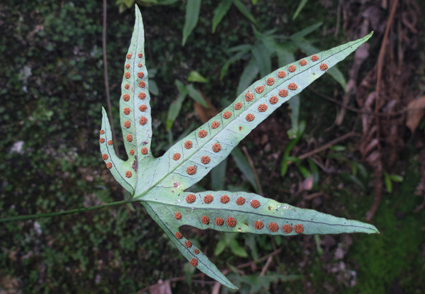Abstract
Selliguea quinquefida (Polypodiaceae), a new calciphilous species from Guangxi, China, is described and illustrated. The new species is the second within the genus with simple and palmate fronds and unique in having simple laminae with cordiform bases. It grows in a peculiar habitat with its rhizome creeping deeply within hardened chalky soils on limestone under relatively dry conditions and always bears palmately 5-lobed fronds with pentagonal shape when fully developed. The differences and habitats among S. quinquefida and all other species with palmate fronds in the genus are discussed.
References
- Bory, J.B.G.M. (1824) Dictionnaire classique d’histoire naturelle. Vol. 6. Rey et Gravier, Libraries-Editeurs, Auai des Augustins, no. 55; Baudouin Frèrer, Libraries-Editeurs, Imprimeurs de la société D’Histoire Naturelle, Rue de Vaugirard, no. 36, Paris.
- Ching, R.-C. (1933) The studies of Chinese ferns—XI. Contributions from the Institute of Botany, National Academy of Peiping 2: 31–100.
- Christ, H. (1905) Les collections de fougères de la Chine au Muséum d’histoire naturelle de Paris. Bulletin de la Société Botanique de France: Mémoires 1: 1–69. https://doi.org/10.1080/00378941.1905.10829209
- Ebihara, A. (2017) The standard of ferns and lycophytes in Japan. Vol. 2. Gakken Plus, Tokyo. 471 pp. [in Japanese]
- Fraser-Jenkins, C.R. (2008) Taxonomic revision of three hundred Indian subcontinental pteridophytes with a revised census-list: a new picture of fern-taxonomy and nomenclature in the Indian subcontinent. Bishen Singh Mahendra Pal Singh, Dehra Dun, pp. 44–45.
- Guangxi Institute of Botany, Guangxi Zhuang Autonomous Region and Chinese Academy of Sciences (2013) Polypodiaceae. In: Li, S.-G. (Ed.) Flora of Guangxi. Vol. 6. (Pteridophyta). Guangxi Sicence and Technology Publishing House, Nanning, pp. 429–430. [in Chinese]
- He, L.-J., Schneider, H., Hovenkamp, P., Marquardt, J., Wei, R., Wei, X.-P., Zhang, X.-C. & Xiang, Q.-P. (2018) A molecular phylogeny of selligueoid ferns (Polypodiaceae): Implications for a natural delimitation despite homoplasy and rapid radiation. Taxon 67: 237–249. https://doi.org/10.12705/672.1
- Hou, X.-Y. (1954) Indicator plants for acidic, calcareous and saline soils in China. Published by Chinese Academy of Sciences, Beijing, pp. 104–105. [in Chinese]
- IUCN. (2022) Guidelines for Using the IUCN Red List of Threatened Species. version 15.1. Available from: https://www.iucnredlist.org/ (accessed: 20 August 2023).
- Lu, S.-G, Hovenkamp, P.H. & Gilbert, M.G. (2013) Selliguea Bory In: Wu, Z.-Y., Raven, P.H. & Hong, D.-Y. (Ed.) Flora of China. Vol. 2–3 (Lycopodiaceae through Polypodiaceae). Science Press, Beijing & Missouri Botanical Garden Press, Saint Louis, pp. 778–779.
- PPG 1 (2016) A community-derived classification for extant lycophytes and ferns. Journal of Systematics and Evolution 54: 563–603. https://doi.org/10.1111/jse.12229
- Liu, B., et al. (2023) China Checklist of Higher Plants, In the Biodiversity Committee of Chinese Academy of Sciences ed., Catalogue of Life China: 2023 Annual Checklist, Beijing, China. Available at: http://www.sp2000.org.cn/ (accessed: 10 Aug. 2023).
- Thunberg, C.P. (1784) Flora Japonica. I. G. Müller, Leipzig [Lipsiae], 335 pp.
- Wang, P.-S. & Wang, X.-Y. (2001) Pteridophyte Flora of Guizhou. Guiyang: Guizhou Science & Technology Press, pp. 499–500. [in Chinese]


